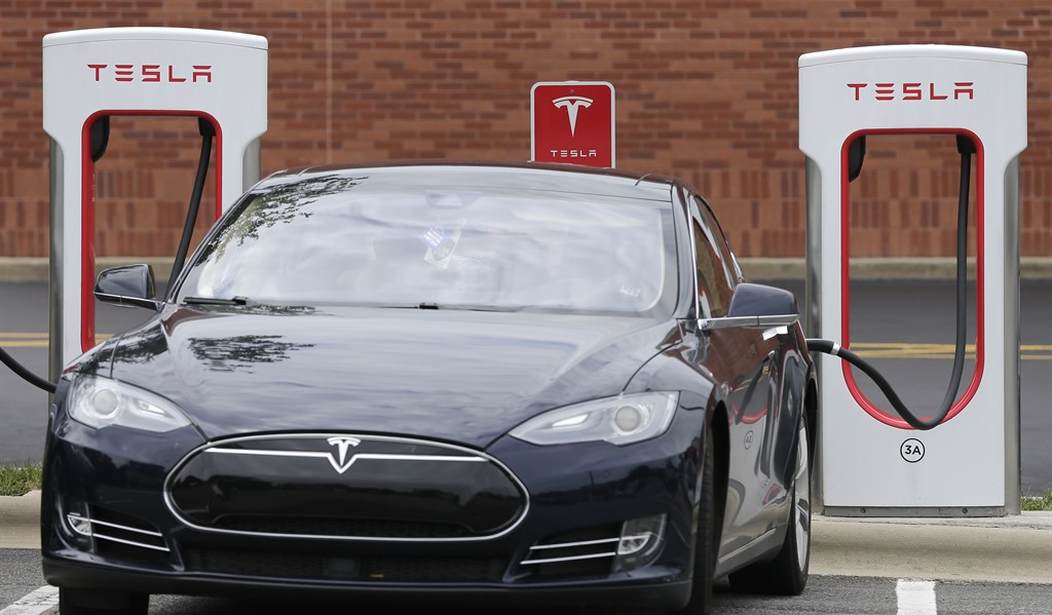The first justification was that internal combustion engines polluted too much. But emissions steadily declined, and today’s cars emit about 3% of what their predecessors did. Then it was oil imports: electric vehicles (EVs) would reduce foreign dependency and balance of trade deficits. Bountiful oil and natural gas supplies from America’s hydraulic fracturing revolution finally eliminated that as an argument.
Now the focus is on climate change. Every EV sale will help prevent assumed and asserted manmade temperature, climate and weather disasters, we’re told – even if their total sales represented less than 1% of all U.S. car and light truck sales in 2016 (Tesla sold 47,184 of the 17,557,955 vehicles sold nationwide last year), and plug-in EVs account for barely 0.15% of 1.4 billion vehicles on the road worldwide.
In recent months, Tesla sales plunged to nearly zero in Hong Kong and Denmark, as huge government subsidies were eliminated. Now Tesla’s U.S. subsidies face extinction. Once its cumulative sales since 2009 reach 200,000 vehicles in the next few months, federal tax rebates will plunge from $7,500 per car to zero over an 18-month period. The same thing will happen to other EV companies that reach 200,000.
Subsidies clearly drive sales for EVs, which are often double the cost of comparable gasoline-powered vehicles. Free charging stations, and access to HOV lanes for plug-ins with only the driver, further sweeten the deal. For those who can afford the entry fee, the ride is smooth indeed. In fact, a 2015 study found, the richest 20% of Americans received 90% of hundreds of millions in taxpayer EV subsidies.
Where were all the government “offices of environmental justice” when this was happening? How much must we subsidize our wealthiest families, to save us from manmade planetary disasters that exist only in Al Gore movies and alarmist computer models?
Recommended
Perhaps recognizing the reverse Robin Hood injustice – or how unsustainable free EV stations are for cash-strapped cities – Palo Alto (where Tesla Motors is headquartered) announced that it will charge 23 cents per kWh to charge plug-in vehicles in city parking garages. Others communities and states may also reduce their rebates, HOV access and free charging, further reducing incentives to purchase pricey EVs.
Meanwhile, Lyft and Uber are also decreasing the justification for shelling out $35,000 to $115,000 or even $980,000 for an electric car that gets very limited mileage per charge. Long excursions still need internal combustion engines or long layovers every few hundred miles to recharge EV batteries.
Intent on advancing its renewable energy and climate change agenda, the California legislature recently enacted a new cap-and-trade law that will generate revenues for Tesla and the “bullet train to nowhere,” by increasing hidden taxes on motor fuels, electricity and consumer products – with the state’s poor, minority and working class families again being hit hardest. State legislators are also close to passing a $3-billion EV subsidy program, primarily to replace the $7,500 federal rebate that Tesla could soon lose. Electric vehicle buyers could soon receive up to $40,000 for buying Tesla’s most expensive models! Coal-billionaire and California gubernatorial hopeful Tom Steyer vigorously supports the new subsidy.
We can also expect a battle royale over extending the federal EV subsidy beyond 200,000 vehicles – demonstrating once again that lobbyists are now far more important to bottom lines than engineers, especially when lobbyists can channel enormous contributions to politicians’ reelection campaigns.
As U.S. government agencies prepare to reassess climate change science, models and disaster predictions, it’s a good time to reexamine claims made about all the utopian electric vehicle and renewable energy forecasts, expanding on the land and raw material issues I raised in a previous article.
In his Forbes article on Battery Derangement Syndrome, energy and technology analyst Mark P. Mills notes that Tesla is also getting $1 billion in taxpayer subsidies to build a huge $5-billion lithium battery factory in Nevada. Batteries, it’s often claimed, can soon replace fossil fuels for backing up expensive, intermittent, unreliable, unpredictable wind and solar power. Mills explains why this is … deranged.
In an entire year, all the existing lithium battery factories in the world combined manufacture only enough capacity to store 100 billion Watt-hours (Wh) of electricity. But the USA alone uses 100 times this capacity: more than 10,000 billion Wh per day. Worldwide, humanity uses over 50,000 billion Wh daily.
Focusing on solar power, Mills notes, that means storing electricity for 12 hours a day – to power homes and businesses around the globe for the 12 hours per day that photovoltaic systems will generate power on sunny days in the 100% solar world of the utopian future – would require 25,000 billion Watt-hours of battery power (ignoring future electricity needs to recharge electric vehicle batteries).
Replacing the gasoline in the tanks of 1.4 billion vehicles worldwide with electric power would require another 100,000 billion Watt-hours. That brings total global demand to well over 125,000 billion Wh of storage. That means it would take 1,250 years of production from every existing lithium battery factory worldwide to meet this combined demand. Or we would have to build 1,250 times more factories. Or we could build batteries that are 10 to100 times more powerful and efficient than what we have today.
Says Mills, the constraints of real world physics on battery storage mean this latter option will not happen.
In a world where we are also supposed to ban nuclear (and most hydroelectric) power, the very notion of eliminating the 80% of all global energy that comes from oil, natural gas and coal – replacing it with wind, solar and biofuel power – is fundamentally absurd. Can you imagine what would happen when the power goes off and on repeatedly while we are smelting iron, copper, aluminum, cobalt or lithium ores … forging or casting metals into components … or running complex fabrication and assembly lines?
In the sustainability arena, has anyone calculated how much lithium, cobalt and other metals would be required to manufacture all those batteries? Where they would be mined – with nearly all the best U.S. metal prospects off limits to exploration and production, and radical environmentalists increasingly rallying to block mining projects overseas? The mines would have to be enormous, and operated by huge corporate consortiums. Will anti-corporate activists on our campuses suddenly have a change of heart?
Will homes, neighborhoods and communities have the electrical service (200 amperes or more per home) to handle all the lighting, computing, entertainment, air conditioning, medical equipment and other requirements of modern living – AND the power required to charge all the predicted electric vehicles? What will it cost to upgrade neighborhood power grids, and home and commercial electrical systems?
Lithium batteries and their component metals pose unique fire and explosion risks. What safeguards will be established to minimize those dangers, in battery factories, homes and public parking garages?
Some factories and batteries will invariably be poorly built, handled or maintained. Some will invariably malfunction – causing potentially catastrophic explosions. The bigger the factory or battery, the bigger the cataclysm. Will we apply the same precautionary principles to them as more rabid environmentalists insist on applying to drilling, fracking, pipelines, refineries, factories, dams and nuclear power plants?
What is the life expectancy of batteries, compared to engines in gasoline-powered cars? Two or three times shorter? What does it cost to replace battery packs compared to engines? Two to three times as much? What is the true overall cost of owning an EV? Four to six times higher than a gasoline car? How will we dispose of or recycle millions or billions of batteries and their dangerous, toxic components?
Is the real goal of all this crony-corporatist wind, solar and battery enthusiasm – and anti-fossil fuel activism – to slash living standards in industrialized nations, and ensure that impoverished nations are able to improve their health and living conditions only marginally?
We would do well to raise – and answer – these and other essential questions now, before we let activists, journalists, legislators and regulators con us into adopting more of their utopian, “planet-saving” ideas.
Paul Driessen is senior policy analyst for the Committee For A Constructive Tomorrow (www.CFACT.org) and author of Eco-Imperialism: Green power - Black death.

























Join the conversation as a VIP Member